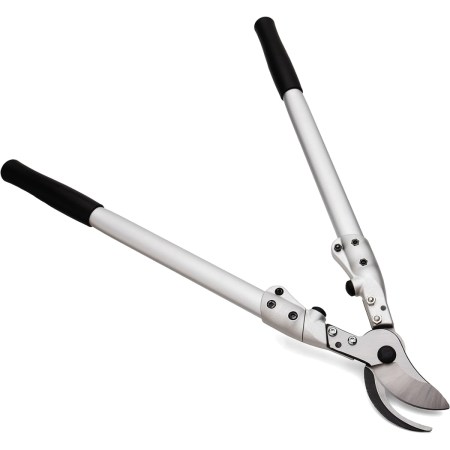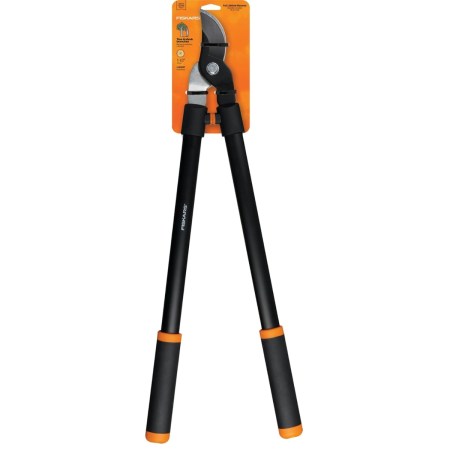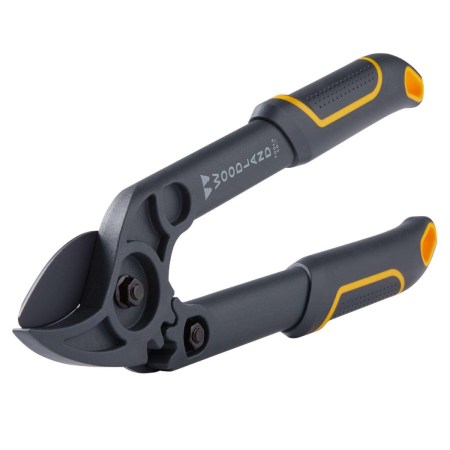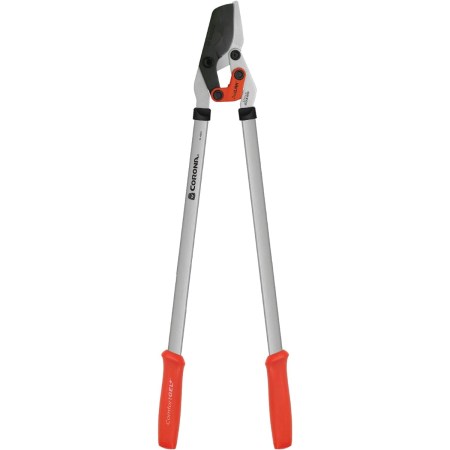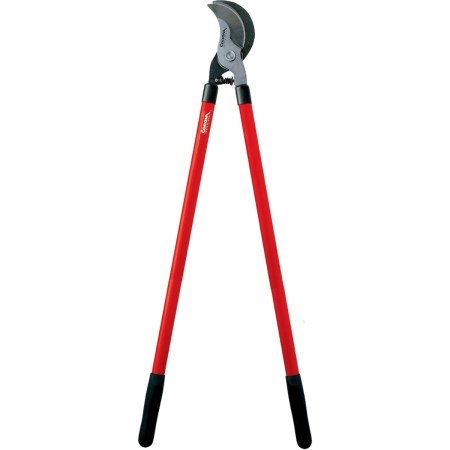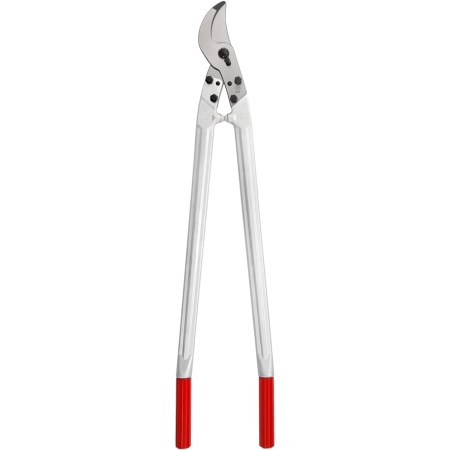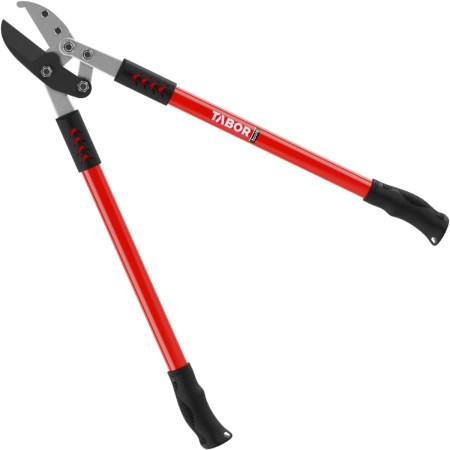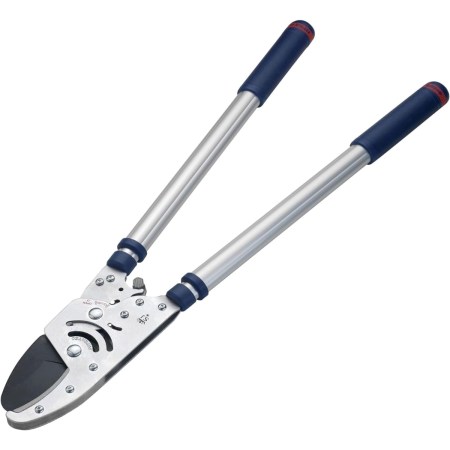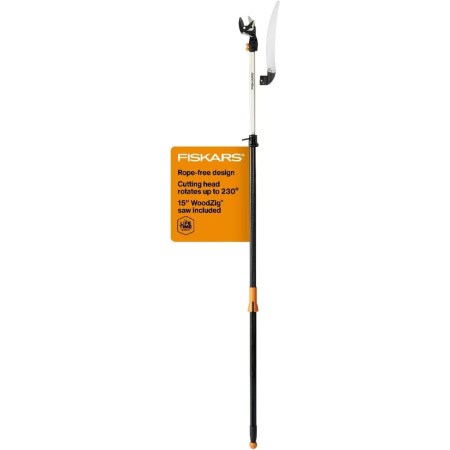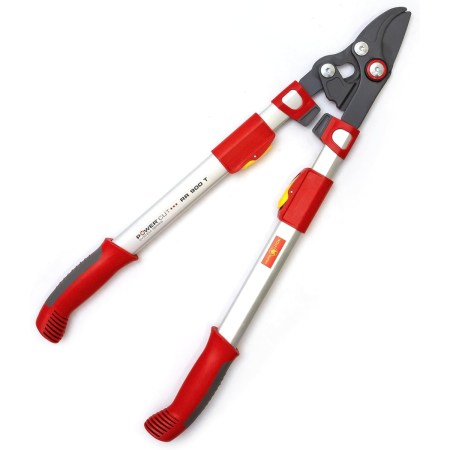We may earn revenue from the products available on this page and participate in affiliate programs. Learn More ›
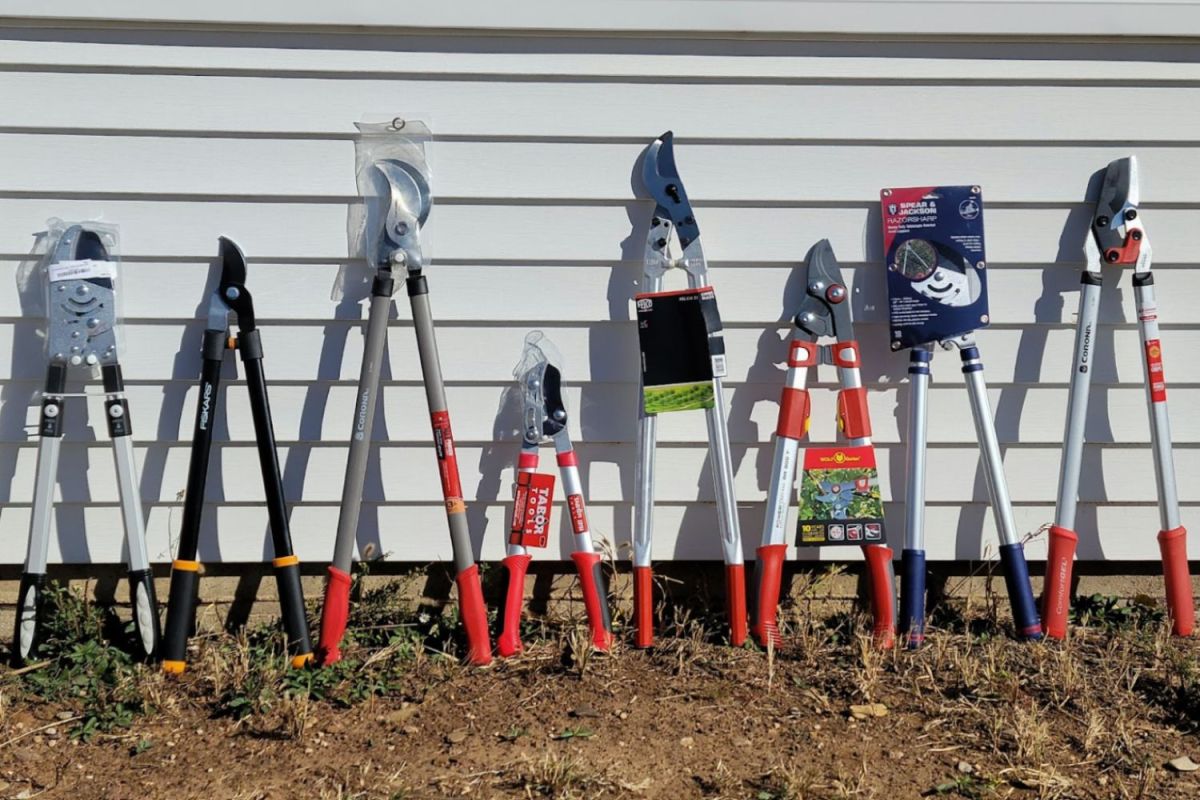
Handheld pruning shears are great for nipping off narrow stems and branches up to ½ inch in diameter, but for pruning thicker branches up to 2 or 3 inches, loppers are often a better fit. Essentially, loppers are the beefed-up version of pruning shears, offering more reach and cutting power. Garden centers and online retailers offer a wide array of loppers, with many of them billed as the best loppers for home landscaping projects.
While some of these tools are excellent, others are just so-so. We tested several loppers from various top manufacturers to find out which ones lived up to their reputations. We certainly put them through their paces—snipping, nipping, and pruning the trees and shrubs in the yard.
We also contacted tree care experts to get their opinion on specific aspects shoppers will want to look for before making a purchase. Ahead, find out what to look for when shopping for this landscaping tool and learn about the pros (and cons) we uncovered when testing the following landscaping loppers.
- BEST OVERALL: Kings County Tools Double-Ratcheting Anvil Lopper
- BEST BANG FOR THE BUCK: Fiskars 28-Inch Bypass-Style Lopper
- EXPERT RECOMMENDED: Felco 22 Two-Handed Pruning Shear Lopper
- BEST COMPACT: Woodland Tools Compact Duralight Lopper
- BEST COMFORT GRIP: Corona Tools DualLINK Bypass Lopper With ComfortGEL
- BEST FOR GREENERY: Corona Tools 32-Inch Super-Duty Bypass Lopper
- BEST FOR DRY WOOD: Tabor Tools GG12A Compound Action Anvil Lopper
- BEST FOR BROKEN BRANCHES: Spear & Jackson Heavy-Duty Telescopic Anvil Lopper
- BEST POLE LOPPER: Fiskars Pruning Stik Extendable Tree Pruner
- ALSO CONSIDER: Wolf-Garten RR900T Telescoping Bypass Lopper
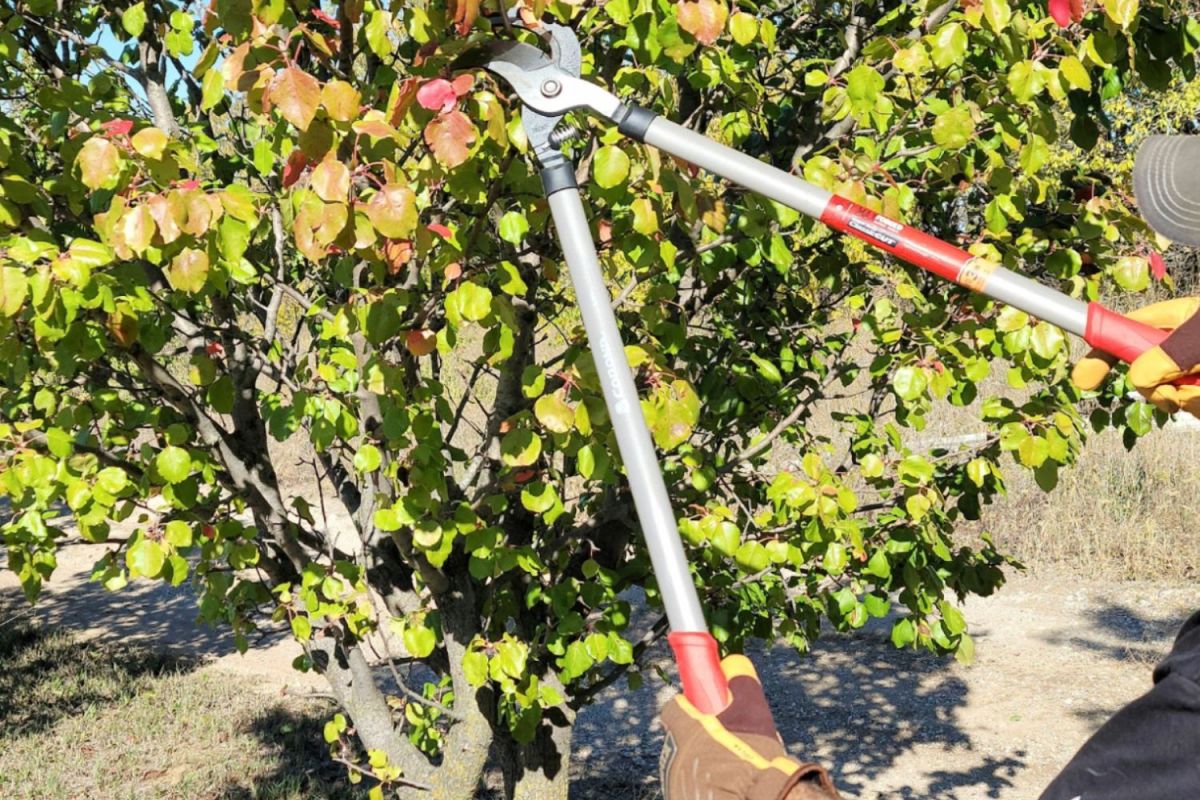
How We Tested the Best Loppers
We tested each set of loppers extensively and analyzed the results. We found that the amount of cutting power the tool could generate and whether it was designed to cut deadwood (anvil) or green wood (bypass) were crucial. We scored each lopper on performance, blade sharpness, ease of use, and durability.
We tested each set of loppers on various branch sizes and noted the dimension of the thickest branches we could comfortably cut. While some of the loppers offer ratcheting action, which is a wonderful addition for its sheer cutting power, each lopper has a limit to what it will cut based on both the width of the blades when fully open and the strength of the user. Did their maximum cutting force require superhuman strength? Were the handles comfortable? These were only a few of the things we considered as we tested each lopper.
The loppers were also evaluated for comfort, whether they came with padded or nonslip grips, and whether the arms were ergonomically designed to maximize a user’s arm strength. We found that a slight inward curve at the grip section of the handles allowed us to generate more leverage. Safety also factored in, especially with ratcheting loppers that will snap shut on a final pump of the handle.
Testing Stats
Products tested: 10
Hours spent testing: 5 hours
Tests performed: 5
Average price: $86
Our Top Picks
We tested each of the following loppers to determine what type of branches they were best suited for pruning (deadwood or green wood) and to determine how well the handles were designed in relation to the blade assemblies. Find out how each one fared to determine if one is the right pick for your landscaping tool collection.
Best Overall
Kings County Tools Double-Ratcheting Anvil Lopper
See ItOur Ratings: Ergonomics 4/5;Ease of Use 4.5/5; Performance 4.5/5; Durability 4/5; Value 4.3/5
Product Specs
- Weight: 4 pounds
- Type and use: Anvil, for dry branches
- Length: 26 to 40 inches (telescoping)
Pros
- Made from quality materials that will last for many seasons of rugged use
- 4-stop ratcheting action builds mechanical pressure, making big cuts easier
- Easy-to-extend arms for a longer reach without climbing a ladder
- Locking lever securely holds the adjustable handles in position
Cons
- Slightly heavy if using overhead, which can lead to fatigue more quickly
- Grips would be more comfortable with a bit more cushioning
The first thing we noticed when the Kings County Tools loppers arrived was their heavy-duty construction. These rugged loppers come with a steel head and forged aluminum arms. When we first spread the handles, the blade snapped to its widest jaw position, and it took four pumps of the handle to close it completely. The ratcheting action generates more cutting pressure with each pump of the handle.
The telescoping handles were effortless to adjust—we just depressed the white buttons on the upper handles and slid the extension arms out. The arms have five individual setting lengths about 3 inches apart, so we could lengthen them just a bit or telescope them all the way out to 40 inches to reach high branches. We were able to trim branches that previously required standing on a ladder to reach.
If you need the convenience of a mid-length lopper most of the time but the reach of a longer tool some of the time, these anvil loppers are a worthy pick. We were impressed by the tough blade of carbon-coated steel—it didn’t dull or nick even with the hardest dry branches. The tool is rated to cut branches up to 2.5 inches thick. We could only cut through a dead branch that was just more than 2 inches in diameter with average pressure, but with extra effort we could cut through one that was nearly 3 inches in diameter.
The Kings County Tools loppers earn the Best Overall spot due to their versatility—they can be lengthened quickly; they offer powerful ratcheting cutting force; and they come with ergonomic, nonslip handles.
Get the Kings County Tools loppers at Amazon.
Best Bang for the Buck
Fiskars 28-Inch Bypass-Style Lopper
See ItOur Ratings: Ergonomics 4/5;Ease of Use 4.5/5; Performance 4.3/5; Durability 4/5; Value 4.7/5
Product Specs
- Weight: 2.9 pounds
- Type and use: Bypass, for green branches
- Length: 28 inches
Pros
- Sharp bypass blade with nonstick coating cuts smoothly and leaves clean edges
- Wipe-clean blade resists sap buildup and corrosion for easier maintenance
- Padded, nonslip grips reduce user fatigue, even with extended use
- Budget-friendly price point won’t break the bank
Cons
- These loppers are not equipped with a safety lock
For reasonably priced cutters that don’t sacrifice performance, these Fiskars bypass loppers are a solid choice. The rust-resistant stainless steel blades are hardened and precision ground, meaning they’ll retain their edge over an extended period. The low-friction coating allows the blades to cut through wood easily and results in less sap residue. We found these Fiskars loppers easy to use on green branches and the cutting action to be supersmooth. We didn’t spot any tearing of the limbs or ragged cuts, which tend to make a tree more susceptible to disease.
These 28-inch cutters are suitable for living green growth with a cutting capacity of branches up to 1.5 inches thick. Shock-absorbing bumpers make the tool easier to use, and padded grips offer additional comfort. While these loppers aren’t the lightest on the list, they still weigh a modest 2.9 pounds, so they’re not difficult to use when cutting overhead.
After testing, we found that the coated nonstick blade wiped clean with just a soft cloth. This is important because other bypass loppers can be difficult to clean, requiring scrubbing with steel wool and a lubricant. All loppers used to cut green wood will get slightly wet and may become covered in sticky sap, so being able to wipe the blade clean is a big plus. Those looking for a quality cutting tool at a reasonable price won’t be disappointed with these Fiskars loppers.
Get the Fiskars 28-inch loppers at Amazon, Ace Hardware, The Home Depot, or Walmart.
Expert Recommended
Felco 22 Two-Handed Pruning Shear Lopper
See ItOur Ratings: Ergonomics 5/5;Ease of Use 4.5; Performance 4/5; Durability 5/5; Value 4/5
- Weight: 4.4 pounds
- Type and use: Bypass, for green branches
- Length: 33 inches
Pros
- Top-quality components and construction, plus all parts are replaceable
- Cuts cleanly through green branches up to 2 inches thick with less effort
- Ergonomic angled handle design maximizes cutting efficiency and reduces fatigue
- Razor-sharp bypass blades resist corrosion and sap buildup
Cons
- One of the more expensive professional-grade loppers available
- No safety lock to prevent blade movement when the tool is not in use
These sturdy bypass loppers are a serious upgrade in performance and ergonomics. In fact, they’re a favorite brand of Kaustubh Deo, the owner and CEO of Blooma Tree Experts, a Seattle-based tree care company featuring ISA-certified arborists and 17+ years of experience. He says, “We recommend Felco as a brand for loppers and other pruning equipment because they produce high-quality equipment that is trusted by professional crews.”
The hardened carbon-steel blades are Swiss made and designed for making clean, precise cuts. Users can also resharpen the blades as needed. Everything about these loppers screams quality. They’re made to last, and all of the parts are replaceable, so this may be the last lopper you’ll ever buy.
The forged-aluminum handles are smooth to the touch. However, the tool weighs in at 4.4 pounds, so it’s not for the faint of heart. With a 33-inch length, these loppers can reach up to trim higher branches. We found it most comfortable to cut branches at waist level or lower. After trimming a few overhead branches, some wrist and arm fatigue began to set in.
The grips on these cutters are nonslip with a slight inward angle, allowing you to exert force while maintaining a more comfortable arm position. Built-in shock absorbers on the handles protect the arms and wrists—so they’re well suited for intense, time-consuming landscaping tasks. This is a lopper for the serious arborist, and it makes sharp, clean cuts on green wood.
Get the Felco loppers at Amazon, The Home Depot, A. M. Leonard, Big Frog Supply, or Felco.
Best Compact
Woodland Tools Compact Duralight Lopper
See ItOur Ratings: Ergonomics 4/5;Ease of Use 5/5; Performance 4/5; Durability 4/5; Value 4.1/5
Product Specs
- Weight: 1.34 pounds
- Type and use: Anvil, for cutting dry branches
- Length: 15.8 inches
Pros
- Compact size is compatible with safe up-close work in dense branches and foliage
- Gear-amplified cutting mechanism makes it easier to cut hardened dry wood
- Ergonomic U-shaped design and comfortable padded grips improve comfort for extended use
- Coated high-carbon steel blades cut cleanly, hold a sharp edge longer, and resist sap buildup
Cons
- Short length is not ideal for reaching high or low branches
Weighing less than 1.5 pounds and about 16 inches from end to end, this Woodland Tools lopper is the most compact, lightweight model we tested. It may not look like much, but it proved to us that it is well built for the task of removing hardened dry branches.
We used the Woodland Tools Compact Duralight lopper to remove the branches from a dead and down apple tree. It made quick work of anything that would fit inside the blade, up to about 1.25 inches thick. The handle grips are soft and comfortable, and the short handles made it easy to move around and work among dense branches.
The ratchet assist gave us mixed results: On one hand it truly helped increase cutting force for cutting hard branches, but it requires a wider handle spread to fully open the blade, which occasionally is not possible when working in a tree canopy. Still, to us, the benefit of the shorter handle length and increased cutting force outweighed the occasional lack of room to spread the handles.
Although the tool does not have a conventional bumper guard to keep the handles from knocking together at the end of a cut, the unique U-shaped design maintains adequate separation to protect the user’s knuckles. This tool offers a lot of usefulness and only one occasional drawback that we uncovered. It’s a smart choice for working on smaller branches in tight spaces.
Get the Woodland Tools loppers at Amazon, Ace Hardware, Menards, or Woodland Tools.
Best Comfort Grip
Corona Tools DualLINK Bypass Lopper With ComfortGEL
See ItOur Ratings: Ergonomics 5/5;Ease of Use 5/5; Performance 3.9/5; Durability 4/5; Value 4/5
Product Specs
- Weight: 3.8 pounds
- Type and use: Bypass, for green branches
- Length: 31.5 inches
Pros
- Handle bumper system absorbs shock and reduces stress on the user
- Comfortable gel-type grips are incredibly comfortable, even without work gloves
- Blade can be resharpened to maintain efficiency and extend the life of the tool
- Narrow blade opening improves tool agility in tight spots
Cons
- The nearly 4-pound tool can feel heavy when used overhead
The ComfortGEL grips on these Corona loppers felt so good, we didn’t even consider wearing gloves when using them. Our hands didn’t slip, so we didn’t have to worry about blisters. The grips offer just the right amount of padding while remaining solid, and the slightly curved shapes fit nicely in our hands.
The compound action loppers are well suited for cutting thick branches. We were able to remove with ease an unwanted branch on an apple tree that was more than 1.5 inches in diameter. The long aluminum arms make it possible to generate a lot of leverage. The additional compound link magnifies cutting force and reduces the necessary work, while sturdy steel handles manage the extra power. At 3.8 pounds, the Corona loppers are heavier than some of the ones we tested, but they’re not quite as heavy as other ratcheting models.
These cutters have a narrower blade opening, so they’re beneficial for getting at hard-to-reach tree limbs. When we first examined the loppers, we were disappointed at what appeared to be a plastic link on the opening mechanism. While it is plastic, it’s actually a bumper guard—an identical steel link on the backside is the actual opening mechanism, so the plastic acts as more of a stabilizer.
Get the Corona Tools DualLINK loppers at Amazon, Ace Hardware, The Home Depot, Walmart, or Northern Tool + Equipment.
Best for Greenery
Corona Tools 32-Inch Super-Duty Bypass Lopper
See ItOur Ratings: Ergonomics 5/5;Ease of Use 3/5; Performance 3.5/5; Durability 4/5; Value 3.9/5
Product Specs
- Weight: 2.8 pounds
- Type and use: Bypass, for green branches
- Length: 32 inches
Pros
- Large head with a deeply curved blade designed for cutting branches up to 3 inches thick
- Blade can be resharpened as needed to maintain a keen edge and easy cutting
- Spring-loaded bumper absorber protects hands from sudden impacts
- Ergonomic padded grips keep hands comfortable and the hold secure
Cons
- No compound or ratcheting action to assist with tougher cuts
- No safety lock to prevent blade movement when the tool is not in use
The curved head on these bypass loppers is large, and the blade is razor-sharp. Our first impression was that the loppers would be out of balance, given the large head size, but they only weigh 2.8 pounds. They don’t come with compound action but rather with massive blades and long handles for leverage. We were able to fit a 2-inch green Empress tree branch between the blades and lop it right off. Oak of the same size was tougher but doable.
At 32 inches long, the Corona Tools super-duty loppers are great for reaching branches overhead. These manual loppers come with padded grips for more comfortable operation, and the cutting blade can be resharpened as needed.
A nice upside to these loppers is the steel-spring bumper located in the opening mechanism that keeps users from jamming their hands together after making a tough cut. We appreciated the bumper when putting extra power into cutting through a green branch that seemed challenging but suddenly gave way. The bumper absorbed the shock, and our arms didn’t.
Get the Corona Tools super-duty loppers at Amazon, Tractor Supply Co., Forestry Suppliers, or Corona Tools.
Best for Dry Wood
Tabor Tools GG12A Compound Action Anvil Lopper
See ItOur Ratings: Ergonomics 5/5;Ease of Use 5/5; Performance 3.8/5; Durability 4/5; Value 4.5/5
Product Specs
- Weight: 3.5 pounds
- Type and use: Anvil, for dry branches
- Length: 30 inches
Pros
- Comfortable nonslip grips reduce user fatigue and slippage
- Long handles add leverage for tough cuts and increase reach for trimming high branches
- Compound cutting actionefficiently adds leverage to increase your cutting ability
Cons
- This tool lacks handle bumpers and has no safety lock
At first, we wondered if the Tabor Tools Anvil loppers would cut through stiff dead branches since they don’t come with ratcheting action. We need not have worried—the loppers instead feature compound-cutting action via a short pivoting arm located at the fulcrum of the blades that increases cutting power.
The manufacturer advertises the loppers as being able to cut through dry branches up to 2 inches thick. We didn’t quite pull that off, but we were able to cut through a dead branch on an elm tree that was 1.5 inches thick.
We were super impressed with the grips on this set of loppers—they’re soft and slightly padded, which allowed us to exert pressure without our hands slipping. At 30 inches long, the sizable arms permitted us to increase leverage on the branches. A shock-absorbing bumper would have been a nice addition, but this is a decent set of loppers for cutting dry wood. At 3.5 pounds, the Tabor Tools loppers are well suited for overhead use without too much wrist and arm fatigue for an average user.
Get the Tabor Tools loppers at Amazon, Walmart, or Tabor Tools.
Best for Broken Branches
Spear & Jackson Heavy-Duty Telescopic Anvil Lopper
See ItOur Ratings: Ergonomics 4/5;Ease of Use 3/5; Performance 4/5; Durability 5/5; Value 4/5
Product Specs
- Weight: 4.2 pounds
- Type and use: Anvil, for dry branches
- Length: 26 to 40 inches (telescoping)
Pros
- Ratcheting action makes it easy to cut through hardened dry branches
- Easy handle-twist feature allows you to adjust the tool length
- Safety lock holds the tool securely closed when not in use
- Carbon-steel blade holds its edge well and can be resharpened when needed
Cons
- Slightly heavy for overhead use
We trimmed away several dead willow branches that were damaged in an ice storm earlier this year with the Spear & Jackson loppers. Willow is hard when dry, but the ratcheting action of these loppers increased the cutting force, and with just a slight pumping action, we were able to cut through dead branches as large as 1.5 inches thick.
These loppers can take a little getting used to; when we first spread the handles, the blades didn’t open until the handles reached their maximum spread, and then the blade head snapped open. It took four pumps of the blade handle to cut completely through a branch from that point. With each pump, the ratchet action increased the cutting force on the branch until it cut through.
While we tested a couple of other sets of telescoping loppers, this one was the simplest to adjust while cutting. We were able to start a cut on a branch, and while the blade head was firmly gripping the branch, we could twist the bottom of the handle and then pull to lengthen it. This is an excellent feature for those who start a cut and decide they need more leverage from longer handles. At 4.2 pounds, these loppers are on the heavy side, so we had to take a few breaks, but they offer a whole lot of cutting power.
Get the Spear & Jackson loppers at Amazon.
Best Pole Lopper
Fiskars Pruning Stik Extendable Tree Pruner
See ItOur Ratings: Ergonomics 4/5;Ease of Use 4/5; Performance 3.7/5; Durability 4/5; Value 3.9/5
Product Specs
- Weight: 4.34 pounds
- Type and use: Bypass, for cutting green branches
- Length: 7.9 feet to 12 feet
Pros
- Pole lopper allows most users to remove branches 15 feet or higher without a ladder
- Compound cutting action makes it easy to cut through branches that are 1.25 inches in diameter
- Removable pruning saw blade extends the tool’s cutting ability to include branches up to 6 inches
- Ropeless design affords greater precision with 2–handed control and no tangles
Cons
- It’s difficult to apply extra cutting force for tough branches; sometimes the saw must be used for moderately sized branches
When it comes to pruning crape myrtles, hollies, and other trees, climbing a ladder is one of the most dangerous parts. The Fiskars Pruning Stik extendable tree pruner allows you to prune branches as high as the second story window without breaking out climbing gear. We used it to shape up a 20-foot-tall cherry laurel.
The Pruning Stik features an articulating lopper that is controlled by a sliding handle at the base of the pole. The lightweight aluminum pole extends and locks in any position between 7.9 and 12 feet long, allowing most users to reach branches 15 feet up the tree or higher. The lopper can accommodate branches up to 1.25 inches thick, and you have the option to attach the removable pruning saw blade for thicker branches up to 6 inches thick.
The pole adjusted quickly and securely with a lever lock to any height between 7.9 and 12 feet. The cutting head also adjusts 90 degrees, from straight in line with the pole to a 90-degree angle, which makes it easy to access and cut the branches from the most convenient direction. We really appreciated how easy it was to reach through “good” branches and selectively remove others higher up the tree. Unlike a pole saw, the compact cutting head of the Pruning Stik rarely becomes snagged on dense branches.
When we had to remove larger branches, it only took a few seconds to attach the saw blade: One wing nut secures the blade to the pole and another one holds the blade at the desired angle. If a tree branch has to be removed and you can’t do it with this tool, it’s probably a job for a professional.
Get the Fiskars Pruning Stik loppers at Amazon, Acme Tools, or Forestry Suppliers.
Also Consider
Wolf-Garten RR900T Telescoping Bypass Lopper
See ItOur Ratings: Ergonomics 5/5;Ease of Use 5/5; Performance 4/5; Durability 3/5; Value 4.3/5
Product Specs
- Weight: 3.8 pounds
- Type and use: Bypass, for cutting green branches
- Length: 25.6 to 35.5 inches
Pros
- Razor-sharp German steel blades easily cut through tough green branches
- Bumper shock absorbers protect the user’s knuckles from sudden impacts
- Ergonomic handles add comfort and reduce user fatigue for extended use
- Smooth cutting action
Cons
- More expensive than most of the other loppers we tested
- Plastic extension mechanisms diminish the tool’s impression of quality
Right out of the box, the Wolf-Garten loppers are impressive looking with their smooth gray German steel blades, sleek aluminum handles, and contrasting red grips and trim. Their cutting ability was just as remarkable.
These quality bypass loppers open and close so smoothly, it’s like gliding—nothing sticks, nothing has to be forced. They feature razor-sharp bypass blades that slice through green branches with ease. We were able to cut through a green branch almost 1.75 inches thick without the blades getting stuck. That’s pretty impressive for loppers that don’t come with ratcheting action. We appreciated the bumper guards that kept the handles from banging together—they made cutting virtually shock-free.
If we could ask for one improvement to the Wolf-Garten loppers it would be different arm-extension mechanisms—we would have preferred steel over plastic levers—for long-term durability. We were able to adjust the length of the handles by depressing the yellow levers on the inside and then pulling or pushing the handles to the desired length. At 3.8 pounds, these aren’t the lightest loppers we tested, but their cutting ability is exceptional, and that alone made them worth the higher price.
Get the Wolf-Garten loppers at Amazon or Wolf-Garten.
Jump to Our Top Picks
What to Consider When Choosing Loppers
At first glance, loppers all look pretty much the same—with two handles that open wide to manipulate their scissorlike blades. But there are substantial differences between models.
Type
Loppers are categorized based on their blades, either anvil or bypass. Each type works better on different types of stems and branches.
Anvil loppers feature a stationary base (anvil) with a groove. They have a movable sharpened blade that presses into the groove when trimming branches. Anvil loppers are suitable for cutting dry, brittle branches and dead stems, snapping them in half with ease. They’re not optimal for trimming soft green branches because they tend to crush and tear the limbs rather than make a clean cut.
Bypass loppers work much like scissors; two sharpened blades overlap one another to make a clean cut. Bypass loppers are best for making sharp cuts on soft, green branches. But cutting through stiff, dead branches with bypass loppers can dull the blades or even leave nicks. Choose a bypass lopper for trimming back green growth, such as shaping an overgrown shrub.
Blade Material
Like many pruning shears, lopper blades are made from steel, but not all steel is the same. Some loppers contain a coating to protect the blade, preserve its edge, and to provide easier cleaning.
Nothing resists staining and rust quite as well as stainless steel. However, it’s not as durable as carbon steel and tends to bend if used on hard, dry branches. Stainless steel blades come at a higher price and aren’t easy to sharpen once they become dull.
The toughest lopper blades are made from carbon steel, and they do the best job of cutting thick branches. On the other hand, these tools rust more easily than stainless steel, so the blades should be wiped clean after every use. You can easily sharpen dull carbon-steel blades with a basic sharpening stone or a carbide file.
A Teflon or titanium coating offers a measure of rust protection to carbon-steel blades. The coating makes it easier to clean sap residue that results from cutting green tree branches. Coated blades hold their sharpness longer, but they too eventually become dull. The coating doesn’t cover the blade’s edge, so sharpening should not remove the coating.
Expert advice: Kaustubh Deo says that “a common mistake folks make when using hand tools like loppers or hand saws is they start using more and more force as the blades get dull. This can lead to safety accidents when a branch finally gives way and you lose control of your tool unexpectedly due to the amount of force you’re applying.” He goes on to say that “just like a kitchen knife, [loppers] are usually safest when the tool is sharp.”
Cutting Action
Deo says that “each cut is a moment of trauma for the plant, so you want it to be precise and quick to limit unintentional damage.” With that in mind, it is important to know that loppers vary in their cutting action, which affects their operation and suitability for specific tasks.
- Manual loppers are the most straightforward option for trimming. The two blades are attached by a single screw at the fulcrum (the support on which a lever turns), providing a basic open-and-close cutting motion. These loppers work best when cutting narrower branches because the user’s strength is solely responsible for the cutting force.
- Ratcheting loppers are designed for slightly easier trimming, particularly with thicker branches. As you squeeze the handles together, the blades latch in place partially through the cut. The tool can be reopened to get a wider and stronger grip without releasing pressure on the branch. Depending on the ratcheting mechanism, the handles may be reopened two or three times to increase cutting pressure.
- Compound-action loppers are built with one or more pivoting arms located at the fulcrum between the two blades to increase cutting force. These loppers are great when you need to cut through thicker branches, although the extra steel makes them heavier and can cause arm fatigue.
Length and Weight
To determine suitable length and weight for loppers, the trick is to know your own strength and cutting needs. The shortest loppers measure about 15 inches from the end of the handles to the tip of the cutting blades, and they can weigh as little as 11 ounces, which is a good length and weight for pruning narrower branches.
Lengthier loppers, measuring 32 inches or more, are handier when you need to reach high branches without having to stand on a ladder. Longer loppers are heavier, with some weighing more than 4 pounds, so they’re more likely to cause arm fatigue.
A long lopper offers more reach and often enhanced power if it uses compound action. But if you can’t make clean cuts with it, opt for a shorter length. Some models have telescoping handles that you can extend or shorten as necessary. Some of the models we tested were relatively large and heavy, and were better suited to trimming branches at or below waist level.
Grips
Many loppers come with padded rubber or foam grips designed to reduce slippage, hand fatigue, and blisters. The softest foam handles feel great in your hands, but they’re also more prone to nicks and tears. If you plan on using the loppers extensively, consider a pair with molded rubber grips that will hold up to the extra work.
While padded grips make pruning tasks more comfortable, it’s still important to wear gardening gloves when using this tool. It didn’t take long during my hands-on tests to discover that a pair of suitable leather gloves was also helpful in keeping blisters at bay.
FAQs
A quality pair of loppers is an arborist’s or home landscaper’s best friend, but dozens of sets are available, and users want to know whether they’re getting a good deal for the price. A few questions are to be expected for those looking to invest in a set (or two) of loppers.
Loppers serve multiple landscaping purposes, from pruning shrubs to cutting the limbs of dead trees. Loppers are like pruning shears with extended handles, and both gardening tools require manual operation.
Loppers require two hands to operate and are designed to cut midsize stems and branches. Pruners are smaller and more closely resemble scissors. Pruning shears require only one hand to operate and are intended for cutting smaller stems and branches.
The most suitable loppers for you depend on intended use, budget, arm strength, and preferences related to material and comfort.
Bypass vs. anvil blades: Bypass loppers are suitable for cutting living plants, like green tree branches and shrubbery, while anvil blades are better at handling dry, brittle branches.
Cutting action: Basic manual models work best on narrow branches; ratcheting cutters are more effective for thicker stems; and compound-action loppers are intended for use on cutting thicker branches. These tools often possess the most cutting power.
Blade material: Stainless steel resists rust and stains, generally requiring less maintenance compared to carbon steel. Blades containing carbon steel do not have these characteristics unless they’re treated with a protective coating. Carbon steel is more rigid, less expensive, and more easily sharpened.
Length: Naturally, longer loppers (33 inches or more) are best for reaching to cut higher branches and shrub leaves. Models with a telescoping handle are versatile and some provide significant length adjustment.
Ergonomics: Cutters with padded grips made of rubber or foam are more comfortable to use. If arm fatigue and wrist pain are concerns for you, go with loppers that weigh less than 3 pounds and have shock-absorbing handles.
This depends on the types of branches and stems you plan on cutting. Bypass loppers are more suitable for sharp cuts through soft, living plants like overgrown shrubs. These blades may dull when used on hard, dead branches. Anvil loppers are more suitable for this type of task, while they tend to crush and tear softer greenery.
A heavy-duty anvil lopper is capable of cutting dead branches up to about 3 inches thick. Some large-head loppers, such as the Corona Tools Super-Duty loppers, can cut green branches up to 3 inches thick.
The Spear & Jackson loppers are one of the best tools for dealing with thicker dead branches with an adjustable length between 18 inches and 30 inches. For telescoping action in a bypass lopper, consider the Wolf-Garten loppers.
Loppers with carbon-steel blades generally require more upkeep. Unlike stainless steel, this material is susceptible to rust and stains. Wipe carbon steel blades clean after each use. Additionally, components of the cutting mechanism should be lubricated to maintain smooth cutting performance.
Why Trust Bob Vila
Bob Vila has been America’s Handyman since 1979. As the host of beloved and groundbreaking TV series including “This Old House” and “Bob Vila’s Home Again,” he popularized and became synonymous with “do-it-yourself” home improvement.
Over the course of his decades-long career, Bob Vila has helped millions of people build, renovate, repair, and live better each day—a tradition that continues today with expert yet accessible home advice. The Bob Vila team distills need-to-know information into project tutorials, maintenance guides, tool 101s, and more. These home and garden experts then thoroughly research, vet, and recommend products that support homeowners, renters, DIYers, and professionals in their to-do lists.
Meet the Testers
Glenda Taylor is a product tester and writer specializing in the construction, remodeling, and real estate industries. She and her husband own a general contracting company, and Taylor is experienced in both residential and commercial building applications. She tests a wide range of power tools as well as other home improvement, household, and lawn-and-garden products.
Mark Wolfe is a writer and product tester with a background in the nursery and landscaping industry. For more than 20 years he mowed, edged, planted, pruned, cultivated, irrigated, and renovated beautiful landscapes. Now he tests and writes reviews about the latest outdoor power equipment, hand tools, lawn-care products, and other outdoor-living goods.
Additional research provided by Mark Wolfe.
